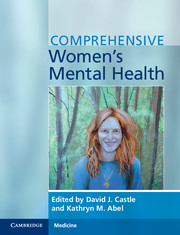Book contents
- Comprehensive Women’s Mental Health
- Comprehensive Women’s Mental Health
- Copyright page
- Contents
- Contributors
- Preface
- Section 1 The social, genetic and environmental aspects
- Section 2 Hormonal and reproductive effects
- Section 3 Violence, self-harm and substance misuse
- Section 4 Depression, anxiety and related disorders
- Section 5 Psychotic disorders in women
- Index
- References
Section 1 - The social, genetic and environmental aspects
Published online by Cambridge University Press: 05 March 2016
- Comprehensive Women’s Mental Health
- Comprehensive Women’s Mental Health
- Copyright page
- Contents
- Contributors
- Preface
- Section 1 The social, genetic and environmental aspects
- Section 2 Hormonal and reproductive effects
- Section 3 Violence, self-harm and substance misuse
- Section 4 Depression, anxiety and related disorders
- Section 5 Psychotic disorders in women
- Index
- References
- Type
- Chapter
- Information
- Comprehensive Women's Mental Health , pp. 1 - 80Publisher: Cambridge University PressPrint publication year: 2016

